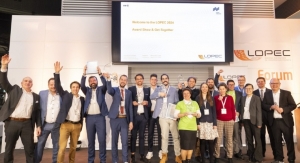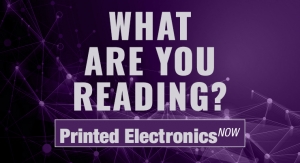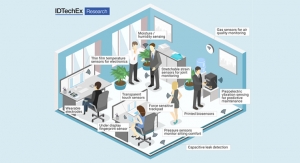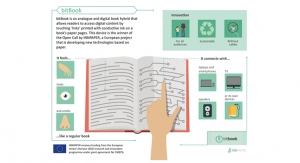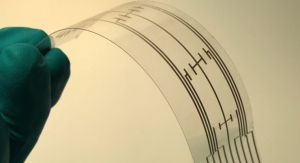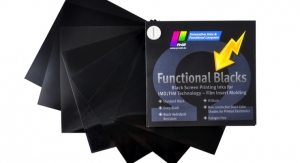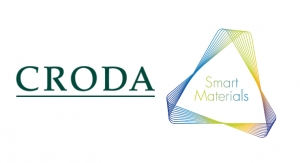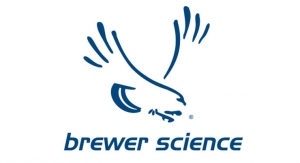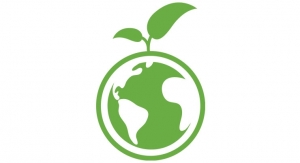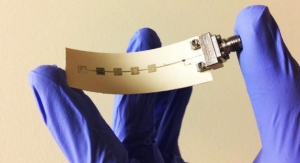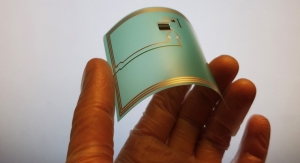David Savastano, Editor04.25.13
As Printed Electronics Europe 2013 concluded its two-day run at the International Congress Centrum (ICC) in Berlin, Germany on April 18, a record number of attendees learned about the progress being made in the field of printed electronics (PE) from speakers and exhibitors alike.
IDTechEx, the conference organizer, co-located Printed Electronics Europe 2013 with a group of its other programs, including Graphene LIVE!; OLEDs LIVE!; TCF LIVE!; Energy Harvesting & Storage; and 5th Photovoltaics Thin-Film Week, a cooperative effort between Thin-Film Week and IDTechEx.
With attendance at Printed Electronics Europe 2013 event growing by more than 20%, IDTechEx CEO Raghu Das said that the conference exceeded expectations.
“The conference went really well,” Das said. “I think there is a lot of end-user interest. We had approximately 1,700 attendees, which is up by a few hundred people. It was nice to bring together some emerging markets that have some synergies, and this conference shows that cross-fertilization can happen.”
Exhibitors said they found the conference to be a strong one.
“We have had good contact with large companies as well as OEM integrators,” said Laurent Jamet, co-founder and director of business development at ISORG. “This show was profitable for us.”
“Overall, we are happy,” said Matt Ream, vice president marketing for Blue Spark Technologies. “”It has been steadily busy, and we have seen a lot of systems integrators here.”
Day 2 Highlights
Dr. Louis Bollens of ESMA discussed "Conductive Low Cost Ink Processes Enable Printed Electronics Applications."
Dr. Bollens discussed the use of nanometal and micro particles in areas such as screen, flexo, aerosol jet and inkjet printing, including some of the challenges of each as well as the cost of the conductive inks.
“Low cost conductive inks have been developed for inkjet, aerosol jet, flexo and screen, based on application specifications,” Dr. Bollens noted, adding that “the high price of nanoparticles will come down in the future.”
Dr. Gunther Dreezen, technical manager, Henkel Electronic Materials Belgium NV, analyzed "Henkel Innovative Ink Technologies: Transparent Conductors, Fine Line Inks and PTC Heating Inks," which featured the advantages and possibilities of fine-line screen printable and halogen-free electrically conductive ink designed for touch screen applications. He noted that these materials offer a printable alternative to indium tin oxide (ITO).
“The advantages are that these materials are bendable and can be printed in a wet process,” Dr. Dreezen pointed out.
Dr. Richard Dixon, managing director for Intrinsiq Materials Ltd., discussed "Conductive Copper Inks - High Resolution Printing and Laser Curing." Dr. Dixon said while silver inks and pastes dominate the $3 billion conductive ink market, copper has the advantage of being 20 times less expensive.
“Silver is more expensive, its pricing is volatile and there are supply issues,” Dr. Dixon added. “Copper is highly conductive, low cost, readily available and flexible.”
Dr. Dixon added that demand for copper screen and inkjet inks and pastes is growing, and noted that Intrinsiq is currently working with more than 100 customers.
One area of interest for PE is consumer goods and toys, and Andreas Meyer, process manager, Ravensburger Spieleverlag GmbH, discussed "Board Games and Electronics." Meyer analyzed the interest in adding electronic components to board games, and noted that consumers hod the key in terms of developing new technologies.
“Players want an all-in-one solution, and low cost technology is required,” Meyer said. “The toy industry is not typically a driver of innovative technologies. We are looking at how to integrate electronics into existing products. We want real interactivity that can be mass produced cost effectively.”
Jani-Mikael Kuusisto, chief business development officer for Ynvisible, followed Meyer with his discussion on "Printed Interactive Graphics for Consumer Packaged Goods Companies."
“Digitalization has had a profound business impact,” Kuusisto said. “Printed electronics offers new levels and interactivity
OLEDs LIVE! featured a presentation by Prof. David Britton, NanoSciences Innovation Centre, University of Cape Town and chief technology officer for PST Sensors. Britton discussed "The Evolution of the Transistor: The Biggest New Development to Transistor Functionality in 65 Years," a look at the discovery of the current switching transistor (CST), a two-way switch.
“We have developed a two-way switch manufactured by printing metal contacts and silicon,” said Britton, who invented the CST with colleagues Margit Harting and Stanley Walton. He noted that researchers at Cape Town have been working on this transistor for five years. “When we realized what we had, we were able to design some pretty interesting devices,” Britton added,
TCF LIVE!, which focused on transparent conductive films, returned from the first day with a series of discussions on touch screens.
Visualplanet director Mike Cole analyzed "Large Format Wire Based Film Projective Capacitive Touch Sensors." He said that these sensors must be delivered on flexible substrates, be a simple construction avoiding multiple layers and be produced through a low cost manufacturing process. As a result, Visualplanet’s products have tremendous market potential.
“We are very much in markets that touch every part of our lives,” Cole said.
After Cole, Bob Mackey, principal scientist, Synaptics, Inc., discusses "Is Metal Mesh the ‘ITO Replacement’ for Touchscreens?"
“ITO is brittle and expensive. We need to come up with new materials that improve on ITO,” Mackey said. “Our metal mesh screens serve the large touch screen market without compromising electrical performance.”
Charles Hendee, Tactonic Technologies CTO, offered his insights into "Lossless Mechanical Interpolation for Cost Effective and Continuously Tile-able Surface Sensing via Flexible Printed Electronics."
“The goal is to reduce costs while making sensors larger, and enable surface interaction everywhere based on mechanical interpolation,” Hendee said. He added that he is convinced that flexo printing will further reduce costs, which will allow transducers to further reach numerous markets, including control panel replacement, medical diagnostics, security, replacement of automotive mechanical actuators and mobile devices.
Track 4 featured talks on Photovoltaics, with DisaSolar technical director Laurence Dassas offering her insights into "Organic Photovoltaics." Disa Solar has excellent experience in printing, and uses offset, screen and inkjet printing in its production of OPVs.
“Our focus is on the automotive market, such as cars, buses and trains,” Dassas said. “OPV is flexible, adaptable to products and lightweight. You can make them colorful or semi-transparent, and can mass produce these cells. In order to succeed, OPV has to focus on differentiation.”
|
|
With attendance at Printed Electronics Europe 2013 event growing by more than 20%, IDTechEx CEO Raghu Das said that the conference exceeded expectations.
“The conference went really well,” Das said. “I think there is a lot of end-user interest. We had approximately 1,700 attendees, which is up by a few hundred people. It was nice to bring together some emerging markets that have some synergies, and this conference shows that cross-fertilization can happen.”
Exhibitors said they found the conference to be a strong one.
“We have had good contact with large companies as well as OEM integrators,” said Laurent Jamet, co-founder and director of business development at ISORG. “This show was profitable for us.”
“Overall, we are happy,” said Matt Ream, vice president marketing for Blue Spark Technologies. “”It has been steadily busy, and we have seen a lot of systems integrators here.”
Day 2 Highlights
Dr. Louis Bollens of ESMA discussed "Conductive Low Cost Ink Processes Enable Printed Electronics Applications."
Dr. Bollens discussed the use of nanometal and micro particles in areas such as screen, flexo, aerosol jet and inkjet printing, including some of the challenges of each as well as the cost of the conductive inks.
“Low cost conductive inks have been developed for inkjet, aerosol jet, flexo and screen, based on application specifications,” Dr. Bollens noted, adding that “the high price of nanoparticles will come down in the future.”
Dr. Gunther Dreezen, technical manager, Henkel Electronic Materials Belgium NV, analyzed "Henkel Innovative Ink Technologies: Transparent Conductors, Fine Line Inks and PTC Heating Inks," which featured the advantages and possibilities of fine-line screen printable and halogen-free electrically conductive ink designed for touch screen applications. He noted that these materials offer a printable alternative to indium tin oxide (ITO).
“The advantages are that these materials are bendable and can be printed in a wet process,” Dr. Dreezen pointed out.
Dr. Richard Dixon, managing director for Intrinsiq Materials Ltd., discussed "Conductive Copper Inks - High Resolution Printing and Laser Curing." Dr. Dixon said while silver inks and pastes dominate the $3 billion conductive ink market, copper has the advantage of being 20 times less expensive.
“Silver is more expensive, its pricing is volatile and there are supply issues,” Dr. Dixon added. “Copper is highly conductive, low cost, readily available and flexible.”
Dr. Dixon added that demand for copper screen and inkjet inks and pastes is growing, and noted that Intrinsiq is currently working with more than 100 customers.
One area of interest for PE is consumer goods and toys, and Andreas Meyer, process manager, Ravensburger Spieleverlag GmbH, discussed "Board Games and Electronics." Meyer analyzed the interest in adding electronic components to board games, and noted that consumers hod the key in terms of developing new technologies.
“Players want an all-in-one solution, and low cost technology is required,” Meyer said. “The toy industry is not typically a driver of innovative technologies. We are looking at how to integrate electronics into existing products. We want real interactivity that can be mass produced cost effectively.”
Jani-Mikael Kuusisto, chief business development officer for Ynvisible, followed Meyer with his discussion on "Printed Interactive Graphics for Consumer Packaged Goods Companies."
“Digitalization has had a profound business impact,” Kuusisto said. “Printed electronics offers new levels and interactivity
OLEDs LIVE! featured a presentation by Prof. David Britton, NanoSciences Innovation Centre, University of Cape Town and chief technology officer for PST Sensors. Britton discussed "The Evolution of the Transistor: The Biggest New Development to Transistor Functionality in 65 Years," a look at the discovery of the current switching transistor (CST), a two-way switch.
“We have developed a two-way switch manufactured by printing metal contacts and silicon,” said Britton, who invented the CST with colleagues Margit Harting and Stanley Walton. He noted that researchers at Cape Town have been working on this transistor for five years. “When we realized what we had, we were able to design some pretty interesting devices,” Britton added,
TCF LIVE!, which focused on transparent conductive films, returned from the first day with a series of discussions on touch screens.
Visualplanet director Mike Cole analyzed "Large Format Wire Based Film Projective Capacitive Touch Sensors." He said that these sensors must be delivered on flexible substrates, be a simple construction avoiding multiple layers and be produced through a low cost manufacturing process. As a result, Visualplanet’s products have tremendous market potential.
“We are very much in markets that touch every part of our lives,” Cole said.
After Cole, Bob Mackey, principal scientist, Synaptics, Inc., discusses "Is Metal Mesh the ‘ITO Replacement’ for Touchscreens?"
“ITO is brittle and expensive. We need to come up with new materials that improve on ITO,” Mackey said. “Our metal mesh screens serve the large touch screen market without compromising electrical performance.”
Charles Hendee, Tactonic Technologies CTO, offered his insights into "Lossless Mechanical Interpolation for Cost Effective and Continuously Tile-able Surface Sensing via Flexible Printed Electronics."
“The goal is to reduce costs while making sensors larger, and enable surface interaction everywhere based on mechanical interpolation,” Hendee said. He added that he is convinced that flexo printing will further reduce costs, which will allow transducers to further reach numerous markets, including control panel replacement, medical diagnostics, security, replacement of automotive mechanical actuators and mobile devices.
Track 4 featured talks on Photovoltaics, with DisaSolar technical director Laurence Dassas offering her insights into "Organic Photovoltaics." Disa Solar has excellent experience in printing, and uses offset, screen and inkjet printing in its production of OPVs.
“Our focus is on the automotive market, such as cars, buses and trains,” Dassas said. “OPV is flexible, adaptable to products and lightweight. You can make them colorful or semi-transparent, and can mass produce these cells. In order to succeed, OPV has to focus on differentiation.”

